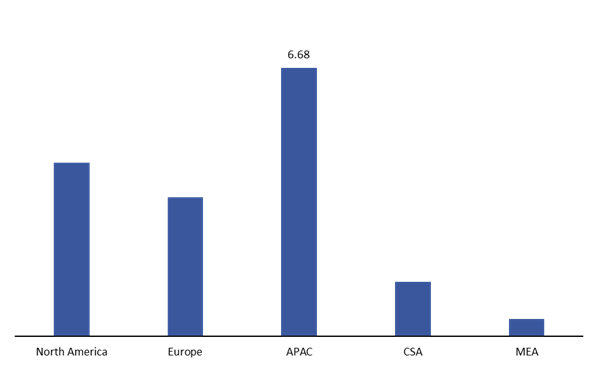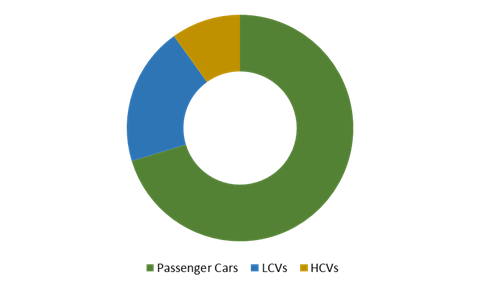Global Automotive HVAC Market Size, Insights, Drivers, Opportunities, By Technology (Automatic, Manual), By Vehicle Type (Passenger Cars, LCVs, HCVs), By Region, Growth, Trends and Forecast from 2019 to 2027
Global Automotive HVAC Market Size, Insights, Drivers, Opportunities, By Technology (Automatic, Manual), By Vehicle Type (Passenger Cars, LCVs, HCVs), By Region, Growth, Trends and Forecast from 2019 to 2027
Historic years: 2015 to 2017 Base Year: 2018 Forecast Years: 2019 to 2027
Number of pages: 100 Category: Automotive Report Id: MISAU5004
Market Insights
The global automotive HVAC market was valued at USD 6.68 billion in 2018 and is estimated to reach a value of USD 15.24 billion in 2027. The market is analyzed to rise at a CAGR of 9.59% over the forecast period of 2019 to 2027. The rise in consumer spending towards the preferences over the luxury and comfort in the automobiles drives the growth of the automotive HVAC market. Moreover, the trends in the market towards the high class systems, largely automatic, intelligence and electrification have also been estimated to maintain the growth in the automotive HVAC market over the forecast period.Global automotive HVAC market size by region, 2018 (USD Billion)
 Primary and secondary market researchers have identified Valeo, Keihin Corporation, Mahle Group, Denso, Hanon Systems, Japan Climate Systems Corporation, Sanden Holdings Corporation, and Calsonic Kansei Corporation as the top players in the global automotive HVAC market. However, considering about the analysis of this segment, factors like company revenue, industry trends towards selecting a particular group and penetration of the automotive HVAC companies for different vehicle types are being considered.
The growth in the market is anticipated by the rising concerns towards luxury, demand of premium products for comfort along with the rise in disposable income and the high & medium class population. The competition is high in the automotive HVAC market due to the number of established players in the industry. The entry of new players in the market creates the demand of the new development in the automotive HVAC, thereby increasing the growth of the product over the forecast period.
Primary and secondary market researchers have identified Valeo, Keihin Corporation, Mahle Group, Denso, Hanon Systems, Japan Climate Systems Corporation, Sanden Holdings Corporation, and Calsonic Kansei Corporation as the top players in the global automotive HVAC market. However, considering about the analysis of this segment, factors like company revenue, industry trends towards selecting a particular group and penetration of the automotive HVAC companies for different vehicle types are being considered.
The growth in the market is anticipated by the rising concerns towards luxury, demand of premium products for comfort along with the rise in disposable income and the high & medium class population. The competition is high in the automotive HVAC market due to the number of established players in the industry. The entry of new players in the market creates the demand of the new development in the automotive HVAC, thereby increasing the growth of the product over the forecast period.
Technology Insights
Automatic technology is estimated to be the largest segment holding a share of about 65.92% share in the market. In 2018, the automatic technology market was estimated to be USD 10.71 billion and is expected to reach USD 25.56 billion in 2027 with a CAGR of 10.15% over the period of 2018 to 2027. The rise in the concerns towards the comfort by the consumers with the demand for the ease in operations drives the growth of the segment over the forecast period. Moreover, the rise of the budget vehicles in the market makes the manual segment to grow at a fastest growth of about 7.83% over the forecast period.Vehicle Type Insights
Passenger cars are the largest segment and are expected to grow at a CAGR of 8.80% over the forecasted period of 2019 to 2027. The rising in the sales of vehicles due to the technological advancements such as hybrid and electric vehicles makes it to provide a higher demand in the market. The rise in the commercial growth in different sectors anticipates LCVs being a fastest segment with a CAGR of 11.51% over the forecast period.Global automotive HVAC market value share by vehicle type, 2027 (%)

Regional Insights
As of 2018, Asia Pacific accounts for the largest share in the automotive HVAC market, with a share of over 41.14% of the global market. The larger inclination of the commercial and passenger vehicles towards the growth in high class population provides the region, a reasonable demand from the global market. The rise of the electronic manufacturing industry in countries such as Taiwan, South Korea, Malaysia and Thailand drives the growth of the market over the forecast period. The report is a thorough market study which includes top companies, their annual presentations, industry publications, press releases and their drivers, opportunities, trends and the market understanding through different modes (Technology, Vehicle Type and Regional analysis) with growth factors and future expectancies in the automotive HVAC market.Research Methodology
The following report consists of market analysis including both primary and secondary research. Primary research comprises the interaction between manufacturers, industry experts and channel partners, while the secondary research presents an analytical interpretation of relevant publications which contains details like proprietary databases, purchased database, company annual reports, and financial reports. For single, team and corporate user license, we will provide 15% free customization of the report. However, alternatively, if you are looking for additional data or insight related to the scope of the report, you may purchase the "Customized Research License". Please put an enquiry for the pricing details.Segments covered in the report
Technology Outlook- Automatic
- Manual
- Passenger Cars
- LCVs
- HCVs
- North America
- U.S
- Canada
- Mexico
- Europe
- Germany
- U.K
- France
- Italy
- Asia Pacific
- China
- Japan
- India
- Central & South America
- Middle East & Africa
- All market drifts, drivers and opportunities
- Understanding the dynamics of the parent market
- Prime fluctuations of the business dynamics
- Historical, current, and projected size of the market with respect to production and sales
- Segmentation and comprehensive analysis in the second or third level
- Reporting and evaluation of recent industry developments
- Detailed profiling of leading companies
- Opportunities to newer trends in global, regional and country markets
- Analyzing the trajectory line of the business
- Measures to consider for automotive HVAC products in the industry
